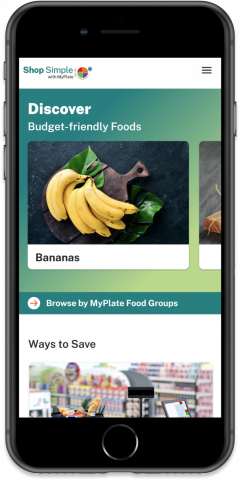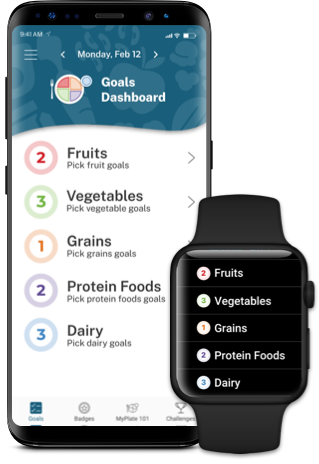About Us
About the USDA Center for Nutrition Policy & Promotion
The USDA Center for Nutrition Policy and Promotion (CNPP) was established in 1994 to improve the nutrition and well-being of Americans. Toward this goal, CNPP focuses its efforts on two primary objectives:
- Advance and promote dietary guidance for all Americans, and
- Conduct applied research and analyses in nutrition and consumer economics.
CNPP's core projects to support its objectives are the following:
- Dietary Guidelines for Americans
- USDA Food Guidance System [MyPlate]
- Nutrition Evidence Systematic Review (NESR), formerly the Nutrition Evidence Library (NEL)
- Healthy Eating Index
- USDA Food Plans
- Nutrient Content of the U.S. Food Supply
- Expenditures on Children by Families
Materials in languages other than English have been created in consultation with experts with professional and lived experience and/or professional translators. The Center for Nutrition Policy and Promotion (CNPP) makes every effort to provide accurate adaptations and/or translations of the original material from English, but due to nuances in language, differences may exist. Please Contact Us if you have feedback on the translation or require clarification or assistance with material. Free translation assistance and language support services are available.
About MyPlate
The benefits of healthy eating add up over time, bite by bite. Small changes matter. Start Simple with MyPlate.
- Make half your plate fruits and vegetables: focus on whole fruits.
- Make half your plate fruits and vegetables: vary your veggies.
- Make half your grains whole grains.
- Vary your protein routine.
- Move to low-fat or fat-free dairy milk or yogurt (or lactose-free dairy or fortified soy versions).
For more information about MyPlate, visit the What is MyPlate? page.
About MyPlate Kitchen
MyPlate Kitchen provides recipes and resources to support building healthy and budget-friendly meals. MyPlate Kitchen includes recipes from the USDA Food and Nutrition Service (FNS) programs including the Center for Nutrition Policy and Promotion (CNPP) and the Supplemental Nutrition Assistance Program (SNAP).
MyPlate Kitchen features are designed to encourage key behaviors emphasized in the Dietary Guidelines for Americans and include the following:
- Detailed nutrition analysis provided on recipes to help consumers choose recipes that meet nutrition goals
- Comprehensive search filters such as program area, equipment, cuisine as well as nutrition-related messages to help users find recipes according to personal interest
- Cost ranges for recipes as available
- A personal cookbook builder
- User-friendly options such as star ratings and sharing on social media
Nutritious recipes and menu planning serve as the building blocks for healthy meals and overall diet. Healthy meal patterns that meet the Dietary Guidelines for Americans are achieved by considering total food intake of a variety of healthy foods over a period of time. While individual recipes may not meet all of the recommendations of the Dietary Guidelines for Americans, collectively they can contribute toward meeting the recommendations and improving lifelong eating habits.
Recommended citation for a recipe from MyPlate Kitchen:
U.S. Department of Agriculture. MyPlate Kitchen Website. Title of recipe. Recipe source (if listed). Available at MyPlate.gov/MyPlateKitchen. Access date: [month, day, year].
Example:
U.S. Department of Agriculture. MyPlate Kitchen Website. Apple Carrot Soup. Recipe source: San Francisco Department of Public Health. Available at MyPlate.gov/MyPlateKitchen. Access date: August 8, 2014.
Direct use of recipes, formatting, artwork, or compilation thereof from the MyPlate Kitchen are required to include proper attribution and do not serve as an endorsement by USDA of products or publications.
About Recipes on MyPlate Kitchen
- Recipes are “MyPlate-inspired” and emphasize nutrient-rich options from the food groups including vegetables, fruits, whole grains, lean proteins, and low-fat or fat-free dairy milk or yogurt (or lactose-free dairy or fortified soy versions).
- Total calories per serving will not exceed a reasonable proportion of an average person’s daily calorie needs.
- Recipes minimize the use of ingredients that provide/contribute added sugars, saturated fat, and sodium.
- Recipes can be used in the context of a total diet to build healthy meals when paired with other meal components, such as serving a fruit or vegetable side dish along with a main entrée.
- If a range amount is provided for an ingredient, the smaller amount is used in calculations.
- When a recipe lists a choice of ingredients, the first ingredient listed is used in calculations.
- The nutrition information does not include optional ingredients; salt is included in the nutrition calculation only when an amount is specified.
- Recipe images may not be from the original source. When prepared, recipes may not resemble the image shown on the recipe page.
- The USDA Center for Nutrition Policy and Promotion (CNPP) works with MyPlate National Strategic Partners in reaching consumers with healthy eating messages. Some recipes featured in MyPlate Kitchen have been developed by MyPlate National Strategic Partners through a Memorandum of Understanding (MOU) Process, which requires Partners to ensure the recipe has been developed or vetted by an appropriate expert. Recipes are reviewed by USDA CNPP for alignment with MyPlate. It is the policy of USDA not to endorse any commercial enterprise, product, or publication.
- Cost calculations for recipes are based on the CNPP 2009 Food Prices Database. The costs presented for recipes are estimates based on national average prices derived using the 2009 Nielsen Homescan Panel. Though the average includes regional price variation, the price estimates may not reflect prices paid by individuals. The costs are updated as they become available.





